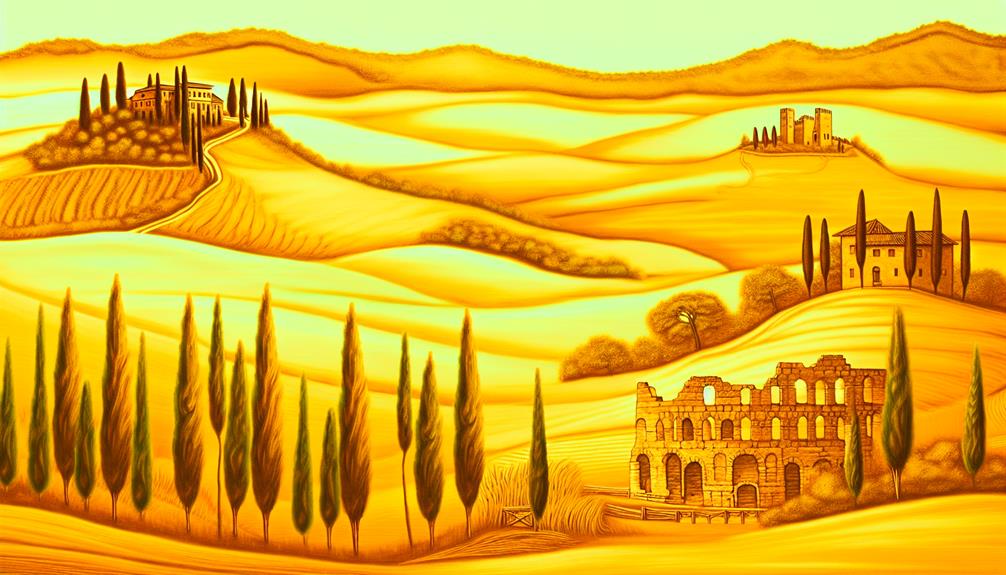Uncovering Tuscany’s Rich History: Castles, Fortresses, and Ancient Sites(Tuscany villas with a view)
Tuscany is a region steeped in history, where ancient castles, fortresses, and archaeological sites tell the story of Italy’s rich past. From the towering medieval walls of Monteriggioni to the majestic Castello di Brolio, these sites offer a glimpse into the lives of nobles and warriors who once ruled this land. Wander through these timeless structures and immerse yourself in Tuscany’s storied heritage. For a memorable stay, consider Tuscany villas with a view and enjoy stunning landscapes that reflect centuries of history.
As you step into Tuscany’s historic landscape, you’ll find yourself surrounded by a rich tapestry of castles, fortresses, and ancient sites that reveal the region’s storied past. You’ll discover majestic castles like Brolio, showcasing medieval and Renaissance architecture, and well-preserved Etruscan ruins in Volterra and San Gimignano, each telling the story of the various civilizations that once flourished here. But what’s behind the impressive facades and fortified walls? What secrets lie hidden in these ancient structures, waiting to be uncovered? The journey to discover Tuscany’s hidden history has just begun.

Exploring Tuscan Castles
As you explore Tuscany’s rich history, you’ll find numerous castles that played a pivotal role in the region’s medieval past.
These castles served not only as fortified strongholds but also as symbols of power and wealth for the noble families who built them. The architecture of these castles reflects the influence of various cultures, including the Romans, Lombards, and the Holy Roman Empire.
You’ll notice that many Tuscan castles are strategically located on hilltops or along rivers, providing natural defense and control over trade routes.
The Brolio Castle, for example, was built in the 12th century by the Ricasoli family and features a unique blend of medieval and Renaissance architectural styles. The castle’s design includes a fortified keep, towers, and walls, which demonstrate the ingenuity of medieval engineers.
As you explore these castles, you’ll gain insight into the complex history of Tuscany and the powerful families who shaped the region’s medieval landscape. Each castle offers a unique glimpse into the region’s rich history, making them a must-visit destination for anyone interested in exploring Tuscany’s medieval past.
Ancient Etruscan Ruins
Beyond the imposing walls of Tuscan castles, a wealth of lesser-known historical sites lies waiting to be uncovered – and the ancient Etruscan ruins are among the region’s most fascinating.
As you explore these ancient sites, you’ll discover remnants of a civilization that thrived from the 8th to the 1st century BCE. The Etruscans left an indelible mark on Tuscan history, with their sophisticated engineering, artistic, and architectural skills.
Their ruins showcase a blend of Greek and Mediterranean influences, with well-preserved examples found in Volterra, San Gimignano, and Chiusi. At Volterra, you’ll find the remains of the Acropoli, featuring the Porta all’Arco and the Porta Diana.
The Etruscan Museum in Volterra houses an impressive collection of artifacts, including intricate jewelry and ceramics. San Gimignano’s Etruscan gates and walls reveal the engineering prowess of the ancient civilization.
Fortified Medieval Towns
Standing atop the rolling hills of Tuscany, the fortified medieval towns offer breathtaking views and a glimpse into the region’s strategic past.
As you explore these towns, you’ll notice a mix of architectural styles, from Romanesque to Gothic, reflecting the various influences and power struggles that shaped the region. San Gimignano, with its iconic towers, is a prime example of a fortified medieval town. Its unique skyline, dominated by 14 towers, was a demonstration of the town’s wealth and power during the Middle Ages.
As you wander through the narrow streets, you’ll notice the town’s defensive layout, with gates, walls, and fortifications designed to protect its inhabitants. The town’s strategic location, perched atop a hill, provided a natural defense against invaders.
Other fortified towns, such as Volterra and Siena, share similar characteristics, with their own unique histories and architectural styles. By exploring these towns, you’ll gain a deeper understanding of Tuscany’s complex past and the role these fortified towns played in shaping the region’s history.